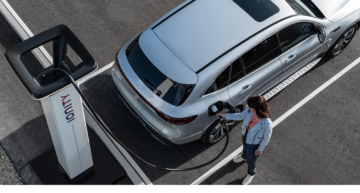50 shades of green: how truly green is your EV?

Green can often be a grey area. Whilst an electric vehicle is emission free, it may or may not be carbon neutral. Allow us to explain. The source of power that generates the electricity that charges your car may not be ecologically sustainable. Think power generated by a natural energy source like wind or water, as opposed to fossil fuels. But with IONITY, you can rest assured that your electric vehicle is powered by a 100% renewable source. Here’s how we do it.
Green can often be a grey area. Whilst an electric vehicle is emission free, it may or may not be carbon neutral. Allow us to explain. The source of power that generates the electricity that charges your car may not be ecologically sustainable. Think power generated by a natural energy source like wind or water, as opposed to fossil fuels. But with IONITY, you can rest assured that your electric vehicle is powered by a 100% renewable source. Here’s how we do it.
Green can often be a grey area. Whilst an electric vehicle is emission free, it may or may not be carbon neutral. Allow us to explain. The source of power that generates the electricity that charges your car may not be ecologically sustainable. Think power generated by a natural energy source like wind or water, as opposed to fossil fuels. But with IONITY, you can rest assured that your electric vehicle is powered by a 100% renewable source. Here’s how we do it.
The desire to go green is often the leading reason for going electric. The most obvious benefit is zero local emissions, meaning that EVs don't pollute the air where they drive with harmful substances like nitrogen oxides, hydrocarbons or particulate matter. However, when it comes to their overall carbon footprint, the situation becomes more complicated. That’s because CO2 emissions depend heavily on the way the electricity is generated. In some countries, electric energy is produced almost entirely from sustainable sources, negating a carbon footprint. In others, the coal-powered power stations and other fossil-fuel sources generate CO2 emissions to such a degree that an EV can have a more harmful effect on the environment than an ICE (a combustion engine vehicle) - an uncomfortable irony. The significant conclusion here is that finding a way to power vehicles with only green energy is the most important step towards truly sustainable mobility. And with transportation being one of the largest contributors to CO2 emissions, this is one of the most important changes we can make for the climate.
Power grid as a lake
Before we deep-dive into how electricity is produced, let’s take a moment to understand how it is consumed. "Electricity is usually not stored. Instead, it is produced and consumed simultaneously. At any point in time, grid operators have to make sure that the demand for energy matches its supply and the frequency in the grid is steady. All energy suppliers feed their energy into something we can think of as an “energy lake”, from where it is taken by each individual consumer at the same time.” – Sebastian Türk, Procurement Manager at IONITY.
What this means is that all energy sources, renewables and non-renewables alike, are all connected to one energy grid. So, it is impossible to trace the path of electrons from their source to our charger or your EV if the energy you draw is coming from this grid. In essence, you can never truly know where or how the electricity that is charging your EV was produced. However, what you can determine is how the electricity that gets added to the grid was generated. To better understand this, let’s refer back to the analogy of the energy grid as an “energy lake”, with many “streams” or sources of power leading to it. If you fill a bucket with water from the lake, you cannot know which stream or source the water really came from. But we can choose which source refills the lake. If we choose suppliers whose streams have clean water instead of polluted water (renewable sources instead of non-renewable sources), then the lake itself becomes a bit cleaner, greener and better for the environment. At the end, the overall effect on the environment is the same as if you bought clean water straight from the supplier. And this is what we do with the power grid: we can’t tell you exactly where each electron we use to charge your EV has come from, but we can tell you that the energy added back to the lake was generated by 100% renewable sources.
Finding a way to power vehicles with only green energy is the most important step towards truly sustainable mobility.
The knowledge of power
The key to driving with a zero-carbon footprint is to know the source of your electricity: who is refilling the energy lake. IONITY only works with energy suppliers who supply 100% renewable energy to the grid. This is ensured by following the EU’s Energy Certificate System, which registers every MWh (MegaWatthours) of renewable energy produced. In a nutshell, this means we can offer a way EV travel is not only emission-free, but truly carbon-neutral. This is one of the most effective brakes we can apply to slow down carbon change. “From my point of view, we have to focus more on renewable energy generation and emission free transportation, if we want to make a real impact.” – Sebastian Türk, Procurement Manager at IONITY.
The future is future-proof
EVs are already emission-free. With 100% renewable energy from source to socket we can make them carbon-neutral, too. Gradually pushing for more renewable energy sources makes these sources more sustainable, while providing a quick and easy way to recharge on long distances makes them more user friendly. This means a cleaner tomorrow that also gets greener with time. With IONITY in charge, that future is almost here, today.
Latest insights & stories

A Global Movement: The World Unites in a Pink Pledge for Clean and Sustainable Water
5,000 participants. 32 countries. €30,000 funds raised. And that's just the beginning.
Picture this: One step that sends ripples across the globe, transforming lives and creating waves of change. You might wonder, how can such a simple action for most of us have such a profound impact?

Sustainability and circularity in construction
Join us in transforming the future of construction, creating buildings that not only stand the test of time but also contribute to a healthier planet!

RainTunes: Shower scenarios for the soul
Light, hearing, smell, and touch: Together with experts, we have developed sensuous scenarios that turn showering into an individual experience. Whether you want to prepare for the day ahead or relax after working out. Whether you want to refresh after a day’s work or unwind at the end of the evening: RainTunes surprises with multisensory experiences.*
*Currently available only in Germany and Austria.